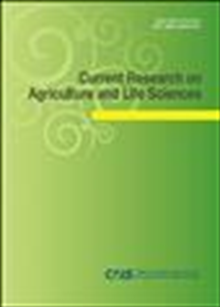간행물
Current Research on Agriculture and Life Sciences 경북대농학지

- 발행기관 경북대학교 농업생명과학대학
- 자료유형 학술지
- 간기 계간
- ISSN 2287-271X (Print)2288-0356 (Online)
- 수록기간 1983 ~ 2015
- 주제분류 농수해양 > 농학 농수해양 분류의 다른 간행물
- 십진분류KDC 520DDC 630
권호리스트/논문검색
Vol. 32 No. 1 (2014년 3월) 7건
Original Article
1.
2014.03
구독 인증기관 무료, 개인회원 유료
본 연구에서 사용한 QRD(Quadratic Residue Diffusor) 마이크로파는 일반적인 마이크로파와 달리 파장의 위상차를 변화시켜 균일한 살균을 유도할 수 있어 저전력으로 효과를높일수있는새로운기술로알려져있다. 따라서친환경적이고 에너지 소비가 적은 QRD 마이크로파를 이용하여 목재를 소독 할 가능성에 대한 기초적인 연구를 수행하였으며 얻은 결과는 아래와 같다. 본 연구에 사용된 QRD microwave의 효율성은 E=5.75e0.32S (R²=0.908)로 나타났으며 초기 수분 함수율은 일정하지 않았고 평균 수분함수율은 30.3%이었다. 자연건조 1주일 후의 수분 함수율은 22.6%로써 평균 약 8% 수분함량이 줄어들었다. 또한 마그네트론의 용량이 3 kW에서 9 kW까지 증가할수록 지수함수적인 관계로 온도 상승시간이 줄어드는 것을 알 수 있었다. 목재 강도 시험 결과에서는 QRD microwave 처리 전후로 휨강도, 압축강도, 할렬의 차이는 없었다. 따라서 QRD microwave 용량을 3, 5, 7, 9 kW로 제작하여 실험한 결과 9 kW가 가장 효율성이 높은 것을 알 수 있었다. 따라서 목재 내부의 선충이나 흰개미 등의 퇴치를 위해서 QRD microwave 용량을 일정부분까지 높여 공급할수록 에너지 효율성에서 유리한 것으로 나타났다.
4,000원
2.
2014.03
구독 인증기관 무료, 개인회원 유료
곳감 생산 현장에 적용하기 위해 식초, 자몽추출물 등 총 6종의 추출물에 대한 배합비를 설정하였고, 그 결과 우수한 활성을 가지는 천연 복합 활성제의 최종적인 혼합비는 정향 18.18%, 계피 9.90%, 감초 9.09%, 천궁 4.55%, 자몽종자출물 4.55% 및 사과 식초 54.54%임을 확인하였다. 대조구 및 처리구의 수분 함량을 측정한 결과는 항갈변 실험과 항진균 실험, 항갈변/항진균 실험 모두에서 전체적으로 1주차에 비해 6주차에서 수분의 함량이 증가 하였으며 측정 주차 별로 control이 처리구에 비해 수분 함량이상대적으로 낮았다. 당도 변화에서는 건조가 진행됨에 따라 전반적 곶감의 당도는 증가하였다. 항갈변/항진균 실험에서 30∼39 °brix로 높은 당함량을 보였다. 경도를 측정한 결과에서는 control과 처리구는 거의 비슷하였으며 6주 뒤 평균적으로 0.5∼0.8정도 줄어들었다. 색도변화에서는 △값의 변화는 건조 기간 중감소하는 경향을 나타냈다. 천연 추출물은 곶감의 건조기간 중에 나타나는 품질저하를 효과적으로 억제하고 유해성 논란이 되고 있는 유황훈증법을 대체할 수 있을 것으로 사료된다.
4,000원
3.
2014.03
구독 인증기관 무료, 개인회원 유료
본 연구에서는 유변물성측정기를 이용하여 HPMC 첨가량, 물 양, HPMC 분자량, 셀룰로오스 에테르 치환체 및 치환도가 쌀 반죽의 압축 및 접착 특성에 미치는 영향에 대해 살펴보았다. HPMC 첨가량이 증가함에 따라 접착강도는 꾸준히 증가하였으나, 압축강도는 2% HPMC 첨가량에서 최대 강도를 보였다. HPMC의 분자량이 증가하거나, 물 양이 감소할수록 쌀 반죽의 압축강도 및 접착강도가 증가하는 결과를 보였다. 이들 인자 외에도, 셀룰로오스 에테르의 치환체 및 치환도도 쌀 반죽의 압축강도 및 접착 강도를 결정하는 중요한 인자임을 확인하였다.
4,000원
4.
2014.03
구독 인증기관 무료, 개인회원 유료
The true bug genus Paromius from Korea is revised taxonomically. It comprises the following three species: P. exiguus (Distant, 1883), P. jejunus (Distant, 1883) and P. gracilis (Rambur, 1839). Among them, P. jejunus (Distant, 1883) is recorded for the first time in Korea. The pest bug injurious to rice culture, known as P. exiguus (Distant,1883), has been recorded erroneously by the previous authors from Korea due to the misidentification, which is rectified here with the support of morphological evidence. All the species of this genus are classified with proper redescriptions, and an identification key to species is provided with illustrations.
4,000원
5.
2014.03
구독 인증기관 무료, 개인회원 유료
김치의 숙성과정 중 일어날 수 있는 식품위생상 이물질의 오염방지를 위하여 혼입시험을 고안하여 이를 모니터링 하였다. 먼저, 시험군은 소금으로 절이고 양념으로 버무린 김치였고, 대조구는 소금에 절이지 않았거나 양념을 하지 않은 배추를 선택하였다. 오염원으로는 배추와 색깔이 유사한 청개구리를 선택하였다. 그 결과, 염분이 첨가되지 않은 대조구에서는 오염원이 10일 이상 생존하였으나 염분이 첨가된 시험구의 이물질은 5일 이상 생존할 수 없었다. 김치제조 중에 혼입된 생물학적 이물질은 대개 5일정도 생존하므로 소비자에 의하여 살아있는 상태로 발견된 사실은 제조 후에 혼입되었다고 추정할 수 있다.
3,000원
6.
2014.03
구독 인증기관 무료, 개인회원 유료
Soy and fermented soy are popular and recognized as a health food among Koreans. Since soy proteins are known to be protease resistant, even to pepsin and pancreatin, it is hypothesized that soy proteins may interact with the intestinal tract and trigger certain physiological reactions. To test this hypothesis, mice were fed diets supplemented with soy, Chunkukjang, or casein. The differentially expressed proteins were analyzed using 2-D gels and identified by peptide mass fingerprinting using mass spectrometry. The majority of the differentially expressed proteins could be functionally grouped into metabolic enzymes and calcium-binding proteins. The differential protein expression by the soy-fed groups was also verified based on a representative protein, tropomyosin, using a Western blotting analysis. In addition, the soy-fed groups exhibited a taller villi structure. Therefore, this study suggests that soy proteins can be an effective nutrient and physiological stimulant for the intestines.
4,000원
7.
2014.03
구독 인증기관 무료, 개인회원 유료
Reactive oxygen and nitrogen species (ROS and RNS, respectively) are messengers that carry signals to alter the redox state in order to activate plant responses and other physiological processes, such as differentiation, aging, senescence, and pathogen defense. Quite a large number of genes are involved in this signaling and lead to oxidative stress in plants. Although the role of ROS/RNS during stress conditions is well documented, a comprehensive list of genes and comparative study of these genes has not yet been completed. Accordingly, the in silico identification of oxidative stress-related genes was performed for soybeans and Arabidopsis. These genes were also studied in relation to multiple domain prediction. The presence of domains like dehydogenase and ATPase suggests that these genes are involved in various metabolic processes, as well as the transportation of ions under optimal environmental conditions. In addition to a sequence analysis, a phylogenetic analysis was also performed to identify orthologous pairs among the soybean and Arabidopsis oxidative stress-related genes based on neighbor joining. This study was also conducted with the objective of further understanding the complex molecular signaling mechanism in plants under various stress conditions.
4,000원

